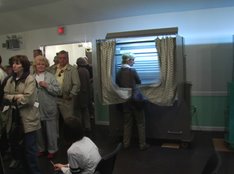New York is finally getting around to purchasing new voting equipment. The Brennan Center put out a press release saying that the Board of Elections was considering purchasing full face electronic voting machines, which are known to have a higher rate of unrecorded votes. Luckily in New York we legally have to have a voter-verified paper trail, so at least we don't have to worry about that - but it would be great if we could really move forward with new ideas, and not keep replaying the same tired scenarios. Here is the letter I wrote to the Board of Elections. Write your own!
John Ravitz
Executive Director
Board of Elections
42 Broadway 7th floor
Dear Mr. Ravitz,
I am writing as a concerned citizen to say please do not purchase full face electronic voting machines for
Here are 2 examples:
From the Brennan Center for Justice website, “David Kimball of the University of Missouri, one of the nation’s foremost authorities on voting system usability … shows that on average, the votes of 15.4% of voters using full faced touch screen machines were not counted for state ballot initiatives in 2004; by contrast, only 8.8% of voters using optical scan machines did not have votes counted for state ballot initiatives.”
Cal-tech did similar studies with similar results from 1988-2000
(Optical scan undervote: 1.5% DRE undervote: 2.3% )
These percentages are significant. They are enough to change a close election, and the percentage of votes lost increases as the voter’s average income decreases.
I also strongly urge you to involve members of the computer science community in this decision making process. People such as Dr. Edward W. Felten, J. Alex Halderman and Ariel J.Feldman of Princeton who were able to create a virus that could change votes from one candidate to another without being detected on a Diebold machine. Ongoing input from the scientific community can help us make advancements in voting equipment instead of making the same mistakes that other states have made.
For example a study at MIT indicated that only 8% of voters actually catch errors on printed receipts, but that the number goes up to 85% if their vote is played back to them by a computer-generated voice through headphones.
Here in
Please have as many demonstrations of the equipment as possible with as much publicity as possible - and additional public hearings - so that the average New Yorker can participate in this very important decision that will be with us for generations to come.

1 comment:
Extech MN16A-KIT Electrical Test Kit with Digital Multimeter, Non-Contact Voltage Detector, and Continuity Tester. The names of men and women in a certain family clan will be handed from generation to generation. When the heat source is activated for a given time interval, an exchange of energy in the form of heat takes place and the temperature of the sample rises. PH PROBE: Gel filled solution and epoxy body construction. Photometry is a technique that measures the brightness of a star in an image.
Post a Comment